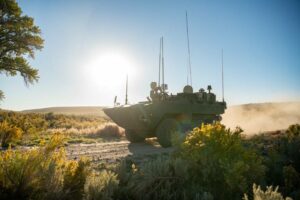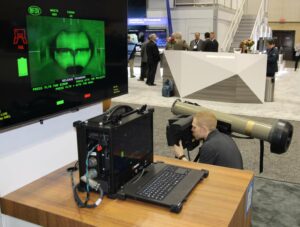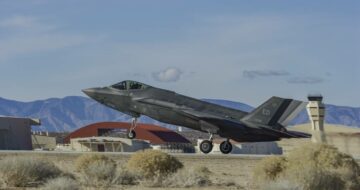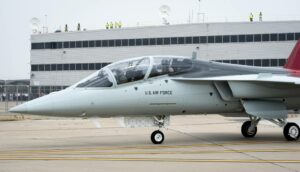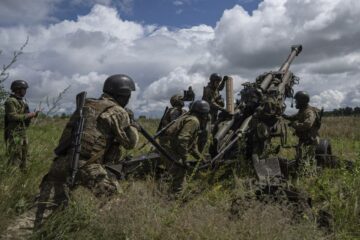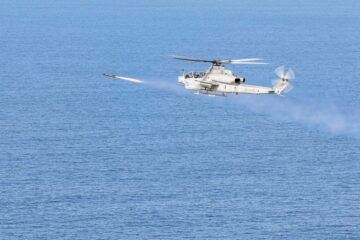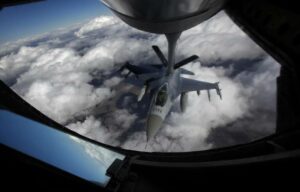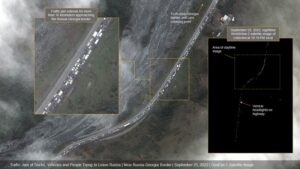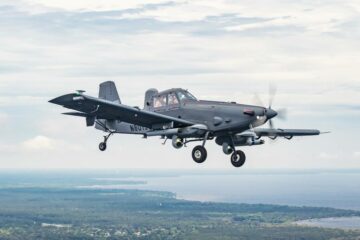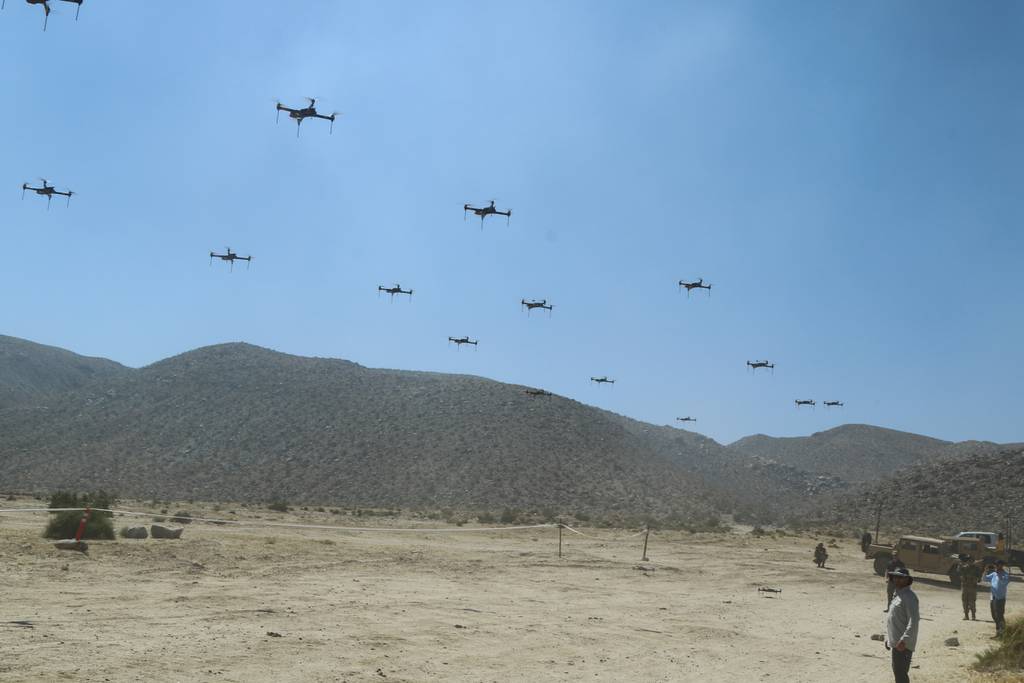
The Army is overhauling nearly every aspect of its combat training centers with new technology and tools that seek to make the demands of a rotation there as close to actual combat as possible.
In the 1980s, the Army rolled out its AirLand Battle doctrine and fielded major weapons systems still in use today such as the Apache and Black Hawk helicopters, M1 Abrams tank, Bradley fighting vehicle, and Patriot missile system, all of which featured into the new training centers.
Units first arrived at the National Training Center at Fort Irwin, California, in 1981. The Joint Readiness Training Center at Fort Johnson, Louisiana, opened in 1987, according to a 1996 report from the U.S. Army Research Institute for the Behavioral and Social Sciences. That combination allowed soldiers to train at scale, as well as gather data from those unit rotations and feed it back into the learning cycle to improve how future units would train together.
With drone swarms, robotic battle buddies, longer-range fires and more realistic simulation technology both in the formations and in the battlespace, a better-equipped training center isn’t a luxury — it’s vital.
Of the many lessons learned at the centers, one in particular has become abundantly clear in recent years, according to Lt. Gen. Milford Beagle Jr., who commands the Combined Arms Center and oversees training center modernization.
“We’re learning one imperative, again from our doctrine: We’re constantly under observation,” Beagle told Army Times ahead of the Association of the U.S. Army’s annual conference
That understanding has, for at least the past few years, been drummed into rotating units to the training centers. Translated to one soldier task, it means: Look up.
“For a couple of decades, if not longer, we hadn’t really had to concern ourselves with looking up,” Beagle explained, because the Army and joint force controlled the skies.
But trainers at the centers can promise units they will face airborne threats in various forms. The addition of vehicles, aircraft, contained internet, cell networks, radar, space-simulated assets and more aims to give soldiers the chance to practice their craft in a wartime environment unavailable at their home station.
Even as these capabilities come to the centers, newer and better Army gear is likely on the horizon for the rotating forces. But that doesn’t mean the opposition forces will be twiddling their thumbs.
“If there is a new capability that we bring in on the blue [friendly forces[ side that gives an advantage, [the opposition forces will] adapt,” Beagle said. “It keeps us agile and changing at pace.”
The centers serve as the “ultimate learning environment” and a crucible of sorts for leader development, Beagle said. According to the Combined Arms Center, combat training center modernization efforts include:
- Opposition force vehicle visual modifications — making vehicles look like enemy vehicles — scheduled to begin in fiscal 2024.
- Instrumented synthetic training environment systems planned for the Joint Readiness Training Center, beginning in fiscal 2024.
- Expansion of the training area at National Training Center Western, expected to wrap up in fiscal 2025.
- Development of tactical drone groups 2 and 3 (approximately weighing between 21 pounds and 1,320 pounds), scheduled to begin in late fiscal 2025, with fielding to start in fiscal 2028.
- Development of man-portable air defense technology, to conclude in fiscal 2024, with fielding to begin in fiscal 2025.
- 5G internet access at the National Training Center, starting in fiscal 2025.
The modernization plan involves more than a dozen priorities. Even more specifically, opposition force mechanized vehicle replication will take M2 Bradley fighting vehicles and add visual modifications to “replicate peer threat mechanized/tracked vehicles,” according to arms center information. That will allow units to get a realistic threat replication not only visually but in thermal, electromagnetic and radar signatures.
The training centers will see the legacy instrumentation systems replaced with new gear through the Army’s Synthetic Training Environment push. The instrumented data feedback will increase the accuracy of simulated fires and their effects during training events.
The National Training Center will grow through area expansion on its western training area and add a simulations center to the site. The Joint Readiness Training Center will also see its borders expand and add a Joint Operations Center in the coming years.
The opposition force will also add electronic warfare, cyber and space operations capabilities to their toolkit. One such tool will be a so-called air jammer to destroy or disable small drones.
Training drones are now set to replicate drone groups 1, 2 and 3 as well as include a swarming option for use against rotating units. That grouping means the drones will range in size from less than 20 pounds to about 1,320 pounds, fly at ranges up to 18,000 feet.
“That’s going to get us back in the practice of looking up,” Beagle said.
The centers will add a closed-loop cellular infrastructure that both the opposition forces and rotating units will use to conduct cellular attacks without disrupting commercial networks.
With the network comes a closed-loop internet for both sides to use for cyberattacks and defense, and both can practice low-power and high-power electromagnetic attacks to simulate electronic warfare capabilities on forces in the field.
That replication of the unseen environments aligns with what Beagle and many modern combat observers have noted: It’s becoming more difficult to hide on the battlefield.
“What does it look like, what does it feel like when you’re getting jammed in reality?” Beagle said. “How do you hide or mask yourself?”
Rotating forces won’t have to pretend their aircraft are getting shot at anymore. A training version of the integrated air defense systems they’d face while fighting the militaries of China, North Korea or Russia will be simulated at those centers.
In addition, opposition forces will have their own ways to shoot back with attack aircraft, using a UH-72 Lakota light utility helicopter as their platform.
The Army is also adding a radar signal emitter and surrogate wheeled vehicles; think technical trucks used by terrorists throughout the wars in Iraq and Afghanistan.
Todd South has written about crime, courts, government and the military for multiple publications since 2004 and was named a 2014 Pulitzer finalist for a co-written project on witness intimidation. Todd is a Marine veteran of the Iraq War.
- SEO Powered Content & PR Distribution. Get Amplified Today.
- PlatoData.Network Vertical Generative Ai. Empower Yourself. Access Here.
- PlatoAiStream. Web3 Intelligence. Knowledge Amplified. Access Here.
- PlatoESG. Carbon, CleanTech, Energy, Environment, Solar, Waste Management. Access Here.
- PlatoHealth. Biotech and Clinical Trials Intelligence. Access Here.
- Source: https://www.defensenews.com/news/your-army/2023/10/09/combat-training-centers-undergo-a-generational-makeover/
- :has
- :is
- :not
- $UP
- 000
- 1
- 10
- 20
- 2014
- 2019
- 2024
- 2025
- 2028
- 320
- 70
- 8
- a
- About
- access
- According
- accuracy
- actual
- adapt
- add
- adding
- addition
- ADvantage
- AFGHANISTAN
- again
- against
- agile
- ahead
- aims
- AIR
- aircraft
- alaska
- Aligns
- All
- allow
- allowed
- also
- an
- and
- annual
- anymore
- Apache
- approximately
- ARE
- AREA
- arms
- Army
- arrived
- AS
- aspect
- Assets
- At
- attack
- Attacks
- back
- Battle
- Battlefield
- BE
- because
- become
- becoming
- been
- begin
- Beginning
- Better
- between
- Black
- Blue
- borders
- both
- Both Sides
- bring
- but
- by
- california
- CAN
- capabilities
- capability
- cell
- cellular
- Center
- Centers
- Chance
- changing
- China
- clear
- Close
- combat
- combination
- combined
- come
- comes
- coming
- commercial
- Concern
- conclude
- Conduct
- constantly
- contained
- controlled
- Couple
- Courts
- craft
- Crime
- cyber
- cyberattacks
- cycle
- data
- decades
- Defense
- demands
- destroy
- Development
- difficult
- do
- does
- Doesn’t
- dozen
- drone
- Drones
- during
- effects
- efforts
- Electronic
- Environment
- environments
- Ether (ETH)
- Even
- events
- Every
- Expand
- expansion
- expected
- explained
- Face
- featured
- Feb
- feedback
- feel
- Feet
- few
- field
- fighting
- Fire
- fires
- First
- Fiscal
- For
- Force
- Forces
- forms
- Fort
- friendly
- from
- future
- gather
- Gear
- Gen
- generational
- get
- getting
- Give
- gives
- going
- Government
- Group’s
- Grow
- had
- Have
- Hawk
- helicopters
- Hide
- Home
- horizon
- How
- HTTPS
- if
- images
- imperative
- improve
- in
- include
- Increase
- information
- Infrastructure
- Institute
- integrated
- Internet
- internet access
- into
- involves
- iraq
- IT
- ITS
- Johnson
- joint
- jpg
- korea
- Late
- leader
- learned
- learning
- least
- Legacy
- less
- Lessons
- Lessons Learned
- light
- like
- likely
- longer
- Look
- look like
- looking
- Louisiana
- Luxury
- M2
- make
- Making
- many
- Marine
- mask
- mean
- means
- militaries
- Military
- Modern
- modernization
- Modifications
- more
- multiple
- Named
- National
- nearly
- network
- networks
- New
- newer
- North
- North Korea
- noted
- now
- observation
- observers
- of
- on
- ONE
- only
- opened
- Operations
- opposition
- Option
- or
- our
- ourselves
- out
- own
- Pace
- particular
- past
- peer
- plan
- planned
- platform
- plato
- Plato Data Intelligence
- PlatoData
- possible
- pounds
- practice
- project
- promise
- publications
- Push
- radar
- range
- Readiness
- realistic
- Reality
- really
- recent
- replaced
- replication
- research
- Rolled
- round
- Russia
- s
- Said
- Scale
- scheduled
- SCIENCES
- see
- Seek
- serve
- set
- Shoot
- shot
- side
- Sides
- Signal
- Signatures
- simulation
- since
- site
- Size
- skies
- small
- Social
- South
- Space
- specifically
- start
- Starting
- station
- Still
- such
- synthetic
- system
- Systems
- tactical
- Take
- tank
- Task
- Technical
- Technology
- than
- that
- The
- the joint
- their
- There.
- thermal
- These
- they
- think
- those
- threat
- threats
- Through
- throughout
- times
- to
- today
- todd
- together
- told
- tool
- toolkit
- tools
- Train
- Training
- training centers
- Trucks
- u.s.
- under
- undergo
- understanding
- unit
- units
- us
- use
- used
- using
- utility
- various
- vehicle
- Vehicles
- version
- veteran
- visually
- vital
- war
- was
- ways
- we
- Weapons
- weighing
- WELL
- Western
- What
- when
- which
- while
- WHO
- will
- with
- without
- witness
- would
- wrap
- written
- years
- you
- yourself
- zephyrnet


